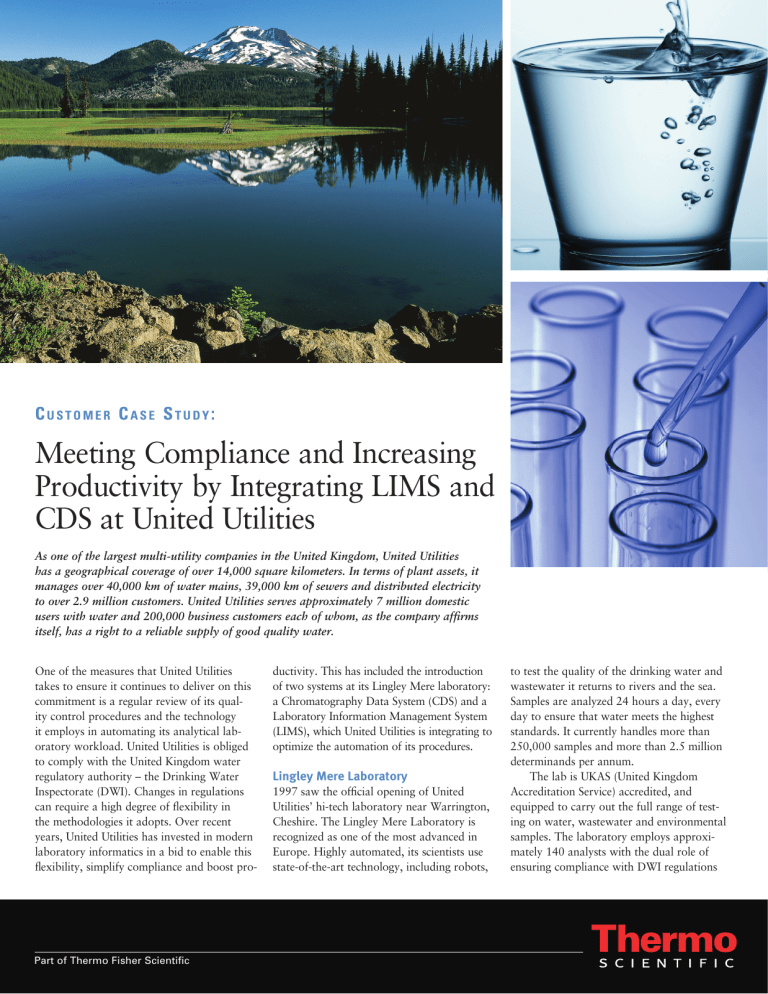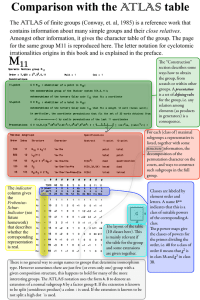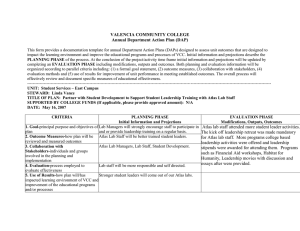
CUSTOMER CASE STUDY:
Meeting Compliance and Increasing
Productivity by Integrating LIMS and
CDS at United Utilities
As one of the largest multi-utility companies in the United Kingdom, United Utilities
has a geographical coverage of over 14,000 square kilometers. In terms of plant assets, it
manages over 40,000 km of water mains, 39,000 km of sewers and distributed electricity
to over 2.9 million customers. United Utilities serves approximately 7 million domestic
users with water and 200,000 business customers each of whom, as the company affirms
itself, has a right to a reliable supply of good quality water.
One of the measures that United Utilities
takes to ensure it continues to deliver on this
commitment is a regular review of its quality control procedures and the technology
it employs in automating its analytical laboratory workload. United Utilities is obliged
to comply with the United Kingdom water
regulatory authority – the Drinking Water
Inspectorate (DWI). Changes in regulations
can require a high degree of flexibility in
the methodologies it adopts. Over recent
years, United Utilities has invested in modern
laboratory informatics in a bid to enable this
flexibility, simplify compliance and boost pro-
Part of Thermo Fisher Scientific
ductivity. This has included the introduction
of two systems at its Lingley Mere laboratory:
a Chromatography Data System (CDS) and a
Laboratory Information Management System
(LIMS), which United Utilities is integrating to
optimize the automation of its procedures.
Lingley Mere Laboratory
1997 saw the official opening of United
Utilities’ hi-tech laboratory near Warrington,
Cheshire. The Lingley Mere Laboratory is
recognized as one of the most advanced in
Europe. Highly automated, its scientists use
state-of-the-art technology, including robots,
to test the quality of the drinking water and
wastewater it returns to rivers and the sea.
Samples are analyzed 24 hours a day, every
day to ensure that water meets the highest
standards. It currently handles more than
250,000 samples and more than 2.5 million
determinands per annum.
The lab is UKAS (United Kingdom
Accreditation Service) accredited, and
equipped to carry out the full range of testing on water, wastewater and environmental
samples. The laboratory employs approximately 140 analysts with the dual role of
ensuring compliance with DWI regulations
and preserving United Utilities’ assets by providing an
information service for its operations department and treatment works. Analysts are engaged in inorganic, organic and
microbiological analyses, delivering QC support for clean
and waste water using a range of techniques.
Eighteen analysts work in the organics laboratory at
Lingley Mere conducting analyses on the levels of organic
compounds in clean water, sewage, effluent and trade discharges, sludges and soils. Their chromatography workload
is supported by Thermo Scientific Atlas chromatography
data system (CDS).
History
In 1997, Y2K compliance had become a key strategic
issue at United Utilities. The operating system of their
HP®/Unix®-based XChrom™ chromatography system was
not compliant and the data system team at United Utilities
opted to migrate to Thermo Scientific Atlas CDS rather
than upgrade to a newer, compliant version of XChrom.
The latter option would have required the purchase of
more expensive computer memory, and there was concern
regarding response times for users.
• Live testing of instruments – this involved comparing
results with those from XChrom.
• Training – this was conducted for two users and two
system managers.
The migration itself was completed over a single
weekend. Analysts logged off from XChrom on the Friday
afternoon and arrived for work on the following Monday
morning for their first experience of using Atlas live.
The organics lab at United Utilities has 20 instruments
(a variety of GC and LC/HPLC) interfaced to Atlas via six
chromatography servers.
User Reaction and Benefits
System Selection and Implementation
Following a review of the available systems and an intensive evaluation, the final decision was taken to move to
Atlas in November 1998. This prompted an ambitious
implementation schedule with the aim of being live by
March 1999. The implementation project included:
• The procurement and installation of new PCs and the
associated networking.
• File transfer sub-project – this involved consultancy
from Thermo Fisher to modify the interface between
Atlas and ChemLMS, the incumbent in-house
developed LIMS. New file transfer protocols were
written to cover file names, sample IDs, standards,
etc., to minimize manual transcription errors. This
was an aspect that was to be revisited and enhanced
with the deployment of a replacement LIMS.
Right from system acceptance, there was general satisfaction amongst users toward Atlas, both in terms of the user
experience and the system’s performance. Due to Atlas’
client/server architecture, result processing was more than
three times faster. In a worst case scenario, with a high
number of XChrom users on-line at any one time, result
processing could take as long as five minutes. With Atlas,
this processing time was reduced to a matter of seconds.
Although United Utilities analysts had become very
familiar with XChrom over many years and considered
it user-friendly, they found Atlas much easier to use. This
was partly due to the modern Windows interface. Within
a couple of hours of Atlas being in production, users were
starting runs, inputting analyses and getting results. United
Utilities could see from the outset that, with the familiar
Windows conventions and the way Atlas had been developed in close partnership with leading chromatographers,
there would be real benefits in system training and getting
new recruits up to speed and productive within a much
shorter timeframe.
This ease of use also extended to reporting. Paul Tonge,
Scientist and Atlas System Manager in Laboratory Services
at Lingley Mere, explains: “Within a month of Atlas being
operational, users were creating their own reports to their
own requirements without any IT support. This contrasted
sharply with the previous situation with XChrom, where
the only reports being produced were those written by IT.
Users found the Windows-based Atlas Report Manager
very easy to use.”
In system administration and problem resolution, Atlas
does not require the expensive specialist technical skills
required to manage the Unix-based XChrom system, since
Microsoft is much more intuitive.
System Flexibility
Atlas’ versatility was another attraction. Tonge continues,
“Atlas handles chromatograms of both clean and waste
water very well. Another strength is its ability to grow with
our business and respond to satisfy new regulatory directives”.
United Utilities has been able to benefit from new
techniques such as flash chromatography due to the high
sampling rate that Atlas allows. Sample throughput has
been reduced from thirty minutes to under two minutes.
The analysts in the organics lab have plans to use different
methods on the same GC, managed by Atlas. This would
mean fewer instruments and reduced maintenance, thereby
reducing operating costs.
Lingley Mere organics laboratory continues to upgrade
to newer versions of Atlas to take advantage of new features such as enhanced reporting functionality. This offers
stronger flexibility in report layout and allows users to
report just the main peaks of interest, thereby simplifying analysis. Users report that it is easier to use and write
methods. Atlas Report Manager offers enhanced calculation capability, automating the calculation of averages of
each sample (rather than the average of a full run), while it
removes the requirement to write specific scripts.
LIMS Selection and Implementation
In the late nineties, United Utilities had validated its
ChemLMS LIMS as compliant with the Y2K bug.
However, the data team was aware that the hardware and
software on which it operated was unlikely to be supported
much longer by the vendor, Hewlett Packard, and it was
becoming expensive to maintain. Another weakness was
that ChemLMS was not configurable by the analysts themselves and required programmer support for even minor
changes. A team was established in 2000 to investigate
commercially available LIMS and to manage an implementation project for a replacement system. The ARMS
(Analytical Report & Management System) project was
initiated.
After extensive review of the market, the ARMS project team arrived at a shortlist of three options for LIMS
that it considered could meet its needs to reduce costs and
permit user configurabilty, while also satisfying technical
and budgetary considerations. After structured demonstrations of each system, Thermo Scientific Nautilus LIMS
was selected for deployment. United Utilities found it
highly user-configurable and that it met more of its user
requirements. The users were particularly impressed with
its intuitive graphical interface. The ARMS project team
was also aware that the choice of another solution from
Thermo Fisher Scientific offered the benefits of single
source support and the management of a single customer/
supplier relationship. The decision was taken to purchase
Nautilus in November 2001.
Following a short series of configuration workshops,
users (with computing experience that extended little
further than using simple formulae in Microsoft Excel)
United Utilities is also working with the Thermo Fisher
implementation services team to integrate Nautilus with
Atlas to allow bi-directional automatic file transfer for all
20 chromatography methods undertaken in the organics
laboratory. Using United Utilities’ former ChemLMS LIMS,
such data exchange was only available for three of these
methods. Automated data and methods transfer between
Nautilus and Atlas eliminates manual data entry and transcription errors. This yields significant time savings, while
avoiding errors, reducing paper and assisting with regulatory compliance. Estimates suggest this could save up to
260 man days a year, on the basis of average worklists of
25 samples, standards, and AQCs, with eight determinands
per sample.
Conclusion
were creating workflows in Nautilus within a few days.
The workshops covered all aspects of LIMS use, including receipt of samples, preparation and registration. The
system’s configuration was based on the outcome of these
workshops and the initial phase (the sewage lab) was for
twelve users. With all areas of the Lingley Mere facility up
and running, there are around 120 Nautilus daily users.
Integration
In addition to connecting with approximately 30 instruments, including Thermo Fisher’s ICPs and LC/MSs,
Nautilus is being interfaced with United Utilities’ sample
planning software program, TAPS (Trilogy Advanced
Planning System). A list of samples is sent from TAPS and
fed into Nautilus, using a flat ASCII file and converted into
XML (eXtensible Markup Language), which is an industry
standard technology neutral data file format. Therefore,
once lab results are authorized after acquisition, they can
be accessed across the whole company and for reporting to
DWI. Analytical data is even accessible as part of the UK
public register, allowing end-user water consumers to check
on quality of drinking water for their area.
United Utilities prides itself on the measures it takes to
ensure a reliable supply of good quality water is delivered
to its customers. Its analytical laboratory at Lingley Mere
is equipped to perform a full range of 24-hour testing on
water, waste water and environmental samples. Its leading
scientists benefit from the knowledge that they are employing sound methods and the latest instruments and software
technology. This ensures they can have total confidence in
their analyses.
The Atlas chromatography data system is providing the
organics laboratory at Lingley Mere with an easy to use
solution that is both responsive in terms of performance
and simple to administer. With close integration between
Atlas CDS and Nautilus LIMS, productivity and efficiency
improvements are achieved via increased automation of lab
procedures.
Finally, the United Utilities ARMS project team is also
reaping the benefits of its decision to source systems from
a single vendor and a single support desk for both systems.
Users have also benefitted from common user interfaces
and operational conventions, along with simplified system
administration.
For More Information
Visit us on the web at www.thermoscientific.com/informatics
or call +1 866 463 6522 (US) or +44 161 942 3000 (Intl).
In addition to these
offices, Thermo Fisher
Scientific maintains
a network of representative organizations
throughout the world.
Australia/Asia
Pacific
+61 8 8208 8307
China
+86 21 6865 4588
France
+33 160924800
Germany/Eastern
Europe
+49 6103 408 0
India
+91 22 67 42 94 34
Latin America and
the Caribbean
+1 713 272 4592
Netherlands/Benelux
+31 76 579 5555
Spain/Portugal
+34 916574930
United Kingdom
+44 1619423000
USA/North America
+1 215 964 6020
© 2010 Thermo Fisher Scientific Inc. All rights reserved.
Part of Thermo Fisher Scientific
UNUTIL-CS410



